by Webmaster | May 9, 2017 | Tobacco-Free Outdoors | 0 comments
According to the Surgeon General, raising the price of tobacco products is one of the most effective strategies for preventing young people from starting, reducing the amount of tobacco used, and increasing the number of people who quit.
Steps New York State has taken:
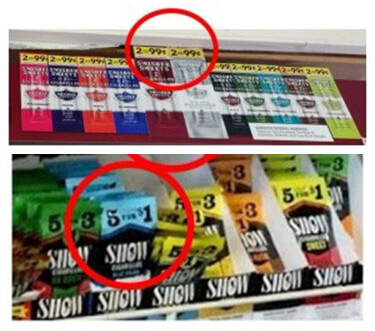
The Food and Drug Administration requires cigarettes to be sold in pack sizes of no less than twenty which keeps the price per pack reasonably high. Other tobacco products (also known as OTPs) are not included in this regulation, leaving products such as cigars, cigarillos, smokeless tobacco, and loose tobacco to be sold at cheaper and more tempting prices such as the products pictured to the left: Swisher Sweets priced at 2 for 99¢ and the Show Cigarillos at 5 for $1.
The results are predictable; OTP use among high school students in 2022 is one and a half times greater than youth cigarette use as illustrated in the graph below.
Fortunately, there are additional steps states and local communities can take to prevent tobacco companies from undoing all the positive benefits of cigarette excise taxes, including:
One of the primary ways that the tobacco and vape industries have attracted new youth users is by selling sweet, fruity and candy-flavored products. Flavors improve the taste and reduce the harshness of tobacco products, making them more appealing and easier for young people to use. Flavors also create the impression that these products are less harmful than they really are.
The rates of NYS high school student use of various tobacco products over time illustrates the power of flavors in attracting youth. Youth cigarette use decreased dramatically after 2009 when flavored cigarettes, excepting menthol, were no longer allowed for sale. During the same period and for the first time, youth use of cigars, cigarillos and chew in flavors like chocolate, wild berry, watermelon, lemonade and cherry dynamite, exceeded the rate of youth cigarette use and is currently nearly twice the rate. After thousands of differently flavored e-cigarettes entered the market in 2013, youth use of e-cigs increased by 160% in NYS between 2014-2018, skyrocketing to an alarming 30.6% of high school students using e-cigs in 2018. Although e-cigarette use among high school students has been decreasing since 2018, more than 1 in 5 high school students still use at least one tobacco product.
Steps New York State has taken:
Menthol cigarettes, along with other sweet, fruity and candy flavors in tobacco products, are used by the tobacco industry as a starter kit for kids. Flavored cigars and little cigars are available in fruit and candy flavors, are widely available, and can be sold in small inexpensive packages. Learn more about the impact of flavored tobacco products on youth tobacco use here.
Menthol takes a particularly significant toll on the health of African Americans because of the tobacco industry’s long history of aggressively marketing menthol to the African American community. As a result, nearly 90% of African American adult smokers use menthol cigarettes as compared to 29% of white smokers. The increased risks associated with mentholated tobacco use led the NAACP to recently recommend that the FDA ban menthol in cigarettes. Learn more about the impact of menthol on the African American community here.
The LGBTQIA+ community has also been a target of tobacco marketing. For more than 30 years, major tobacco companies have tried to present themselves as allies to LGBTQIA+ communities through representation in tobacco ads, sponsorship of Pride events, and financial support to HIV/AIDS organizations. The goal was to make smoking, and menthol cigarettes in particular, an accepted part of queer culture. This aggressive strategy contributes significantly to LGBTQIA+ people using tobacco, including menthol cigarettes, at higher rates than people who are cisgender and straight. Learn more about the impact of tobacco use on the LGBTQIA+ community here.
Restrict the sale of flavored tobacco products, including menthol.
If your school or youth serving organization is interested in partnering with our program, please fill out our contact us form.
Hear why Genevieve is involved in Reality Check in the video to the right.
Ash has been a member of the Capital District Reality Check group since August 2020. He is currently a freshman at Columbia High School in Rensselaer County and resides with his family in East Greenbush.
Hear why Mok is involved in Reality Check in the video to the right.
Hear why Jay is involved in Reality Check in the video to the right
Hear why Evan is involved in Reality Check in the video to the right
Raji Ramasamy is currently studying Biology at the University at Albany. She was a member of Capital District Reality Check from June 2020-June 2022.
While involved in Reality Check, Raji has had the opportunity to stay connected to her community and be a part of a statewide movement that promotes public health by creating policy changes. She believes that the skills she developed with Capital District Reality Check will help her in college and beyond.
Rishita is currently studying Neurobiology at Rensselaer Polytechnic Institute (RPI). She was a Reality Check member from July 2018 until June 2021. She graduated from Tech Valley High School in Albany County.
As a result of being a part of Reality Check, Rishita learned the importance of being involved in her community and collaborating with others to make a difference. She believes it’s important for young people to get involved in Reality Check because it can open many new opportunities for them to gain leadership and communication skills.
Praaghya is currently studying Business at Binghamton University. She was a Reality Check member from March 2018 until June 2021. She graduated from Columbia High School (Rensselaer County) and is the 2020 Capital Region Tobacco-Free Youth Ambassador (YAYA) of the Year.
During her time with Reality Check, Praaghya became more comfortable speaking with community residents and decision makers about the problem of tobacco marketing in her community. She has stayed involved in the program because she enjoys being a part of the movement that exposes the lies of the tobacco industry.
Check out this footage of Praaghya finding out she is the Capital Region Youth Ambassador for 2020.
In New York State, stores are required to register with the state if they want to sell tobacco products, including e-cigarettes, and are subject to regular inspections to ensure that they are complying with New York State laws regarding the sale of those products. These inspections are usually carried out by County Departments of Health. Violations of state law can result in the imposition of fines and/or stores can have their licenses suspended or revoked.
Local municipalities have the authority to place additional restrictions on the sale of tobacco products, including decisions related to the type and location of stores that sell tobacco products. In NYS, several local governments have, for example, prohibited the sale of tobacco products in pharmacies, contending that health care providers ought not be selling a product that is the #1 cause of preventable death and disease. Local governments have also instituted limits on the total number of retailers that can be registered to sell tobacco products, and restrictions on how close to schools stores can be located.
Steps NYS has taken
The number of licensed tobacco retailers can vary dramatically from one community to another. The more tobacco retailers there are, the more exposure residents have to tobacco marketing. The more exposure to tobacco marketing, the more likely youth will start smoking, adult smokers will experience more cravings and impulse buying, and people trying to quit will be less successful.
The density of tobacco retailers (number of tobacco retailers per capita) is typically higher in low-income neighborhoods than in higher-income neighborhoods. This helps to explain the disproportionately high rate of smoking among New Yorkers with the least education and income who are 43% more likely to smoke than those with higher income and education.
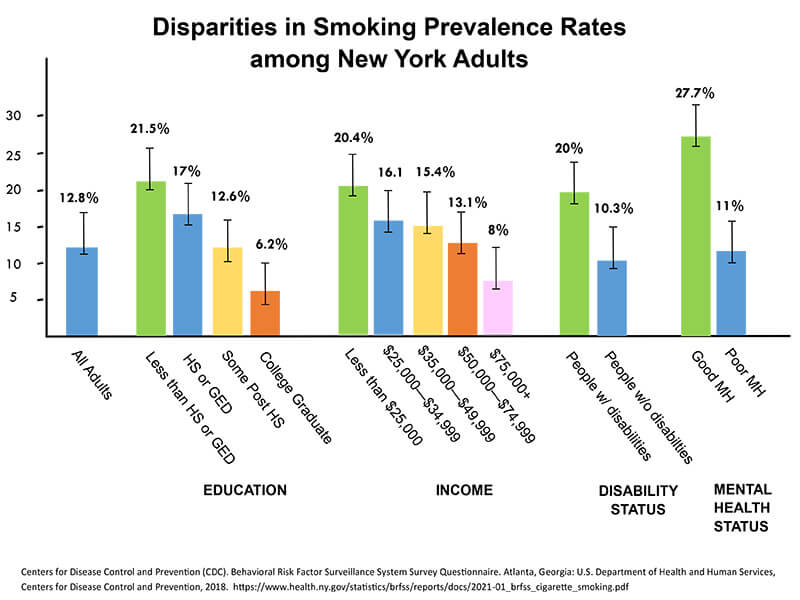
While the tobacco use rate has steadily declined overall in the past decade, tobacco use is not an equal opportunity killer. Many factors contribute to the higher rates of smoking among those with the least education and income, and exposure to tobacco marketing is one of them.
This infographic from ChangeLab Solutions and CounterTobacco illustrates various ways in which policy solutions can reduce tobacco retailer density.

In 1998, significant restrictions were placed on the ways in which tobacco companies could market their products, including bans on billboard advertising, the use of cartoon characters, and limits on the distribution of branded clothing and other merchandise.
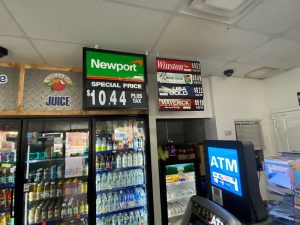
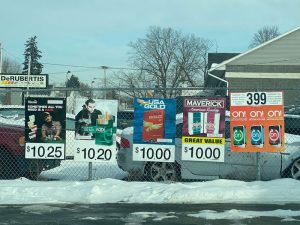
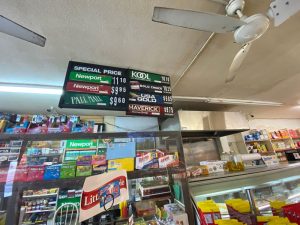
On the heels of these restrictions, stores that sell tobacco became the primary focus of tobacco industry marketing. Marketing strategies at the point of sale include:
You may not have seen all the tobacco marketing in the stores, but your kids have. It’s right there by the register, where they check out. Tobacco product displays, on average, take up 34 square feet of space in the most visible location in stores–directly behind the checkout counter.
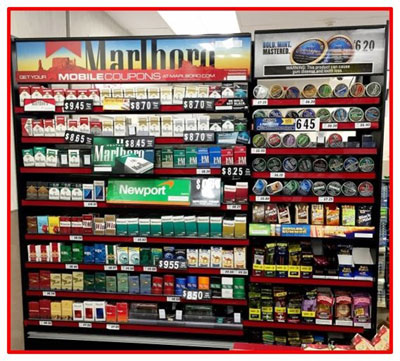 To the left is a typical tobacco product display. If you don’t use tobacco, you may not even notice, but kids do. Kids see. Kids notice. Kids remember. In fact, kids are more than twice as likely as adults to notice and remember retail tobacco marketing.
To the left is a typical tobacco product display. If you don’t use tobacco, you may not even notice, but kids do. Kids see. Kids notice. Kids remember. In fact, kids are more than twice as likely as adults to notice and remember retail tobacco marketing.
Tobacco companies require stores to enter into contracts that dictate how products are displayed. If store owners don’t abide by the contract, the tobacco companies may withdraw their product from the stores.
Tobacco industry contracts with retail stores also dictate the type and location of signs advertising tobacco products both inside and outside the stores. In NYS, retail stores average 21 interior tobacco ads. Exterior ads, (which can be up to 14 sq ft or about 5.5′ x 2.5′), are often placed on light poles and gas pumps.
Steps NYS has taken:
Tobacco marketing at retail stores is effective in capturing the attention of young people and making them more likely to smoke. Consider:
Yasmin has been a member of Reality Check since December 2018. She gradutated from Niskayuna High School in June 2020 and is currently a student at RIT studying Bio Medical Engineering.
One of the reasons Yasmin joined Reality Check was because she is passionate about protecting her peers from being deceived into trying flavored tobacco products that lead to a lifelong addiction to nicotine. She believes it’s important for young people to get involved in Reality Check in order to help create tobacco-free communities that benefit the health and wellbeing of the families not only here in the Capital District but in New York State.